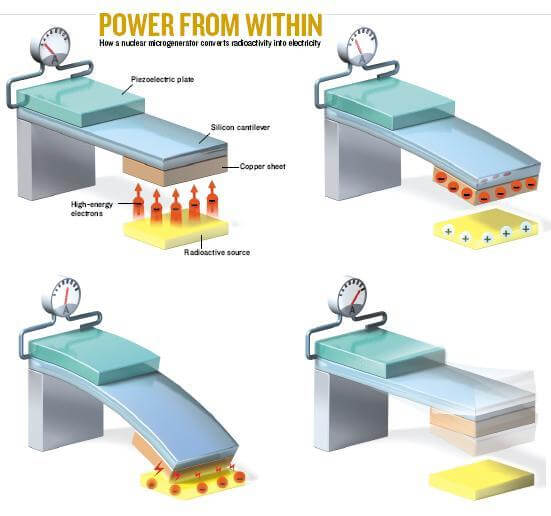
They don’t have the pomp and flair of the Teenage Mutant Ninja Turtles, but Nuclear Cyborg Insect Spies are still shell-shocking researchers in the world of miniaturized electronics. We’ve already reported on how DARPA funded research teams are using electrodes to control insects in flight to adapt them for surveillance. The associated group at Cornell, however, is trying to solve the problem of getting cyborg bugs to carry heavy batteries. The solution: ditch traditional chemical cells and use light weight nuclear power instead. Amit Lal and his team are adapting a microelectromechanical system (MEMS) that generates electricity from radioactive decay to work with the flying insect project. They recently presented their work at the International Electron Devices Meeting sponsored by IEEE. The nuclear powered MEMS doesn’t use fusion or fission but rather harnesses the natural release of power from an unstable isotope, Nickel-63, as it turns into copper. These MEMS nuclear batteries won’t just power the insect spies of the future, they could provide electricity for all sorts of micro devices, allowing them to run for a hundred years without a recharge.
The nuclear battery MEMS works by collecting the radiation from the Nickel-63 onto a small cantilever that is only 40 microns thick and 4 to 8 mm long. Nickel-63 releases beta particles (electrons) onto the cantilever which slowly charges and is attracted to the sample. The lever discharges as the two touch and then springs back. This springing back is what generates electricity (via a piezoelectric transducer). The cantilever then begins to slowly charge again and the cycle repeats. See the diagram for a demonstration. It sort of reminds me of a nuclear version of the Drinking Bird.

Lal is using the nuclear MEMS to power a transmitter for the cyborg insect spies. Due to the intermittent nature of the electricity (power is only harnessed during the spring-back ) the RF transmitter attached to the battery only signals once every 3 minutes. That interval can be changed, however, by adjusting cantilever length (at a cost of power). Right now the MEMS generates 5 milliwatts for 10 microseconds – enough power to act as a wireless node, perform periodic sensing/processing, and communicate with other devices.
The great benefits of nuclear powered batteries are their very long lives and very high energy densities. Nickel-63 has a half life of a hundred years (IEEE says 12?) which is much better than the year or two shelf life for most chemical batteries. Also, Lal’s nuclear MEMS is only 0.06% efficient but still provides enough energy for the RF transmitter and is less than 1 square inch in size. When the device is eventually optimized, it could provide much more power. Nuclear MEMS could provide the means to create insect spies, or place tiny sensors in buildings and bridges to track stress over their lifetimes, or cover the globe in weather tracking beacons. One day we may have nuclear batteries in all our small scale electronics.
Critics will rightfully worry about the ramifications of using so much nuclear power and so close to living things. The beta particles emitted from Nickel-63, however, are not very energetic. They can be blocked by a few sheets of paper, and only penetrate about 20 microns into exposed flesh. That’s probably not enough to be a major health hazard, although more research will needed to make sure. Unlike fission, radioactive decay does not leave us with radioactive waste but rather an radioactively inert (generally non-toxic) element. There’s yet to be a study on how long-term exposure to a nuclear MEMS will affect cybernetic insects, but my guess would be that very little will happen over the life of the bug.
Still, this technology remains in the testing stages, and it’s too soon to predict how and where it will eventually be used. The Cornell team has had similar MEMS devices in development since 2004 without drastic changes, so it’s hard to say if the technology will advance quickly in the next few years. Hopefully, however, nuclear MEMS will be thoroughly explored and tested to see if they could become the next paradigm in powering electronics. We’ve had the same chemical batteries, more or less, since the 1800s. It’s time for an upgrade. As for the Nuclear Cyborg Insect Spies…we’ll let you know if the radiation makes them more effective at their jobs…or just prepares them for a career in Saturday morning cartoons.
[photo credits: Wiki Commons, Amit Lal, IEEE]


